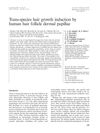Dermal Papilla Cell-Derived Extracellular Vesicles as the Future Tools for Hair Regeneration

TLDR Dermal papilla cell-derived exosomes can help stem cells grow hair.
The study investigates the potential of dermal papilla cell-derived exosomes (DPC-Exo) to induce hair growth properties in adipose-derived stem cells (ASCs). By characterizing DPC-Exo and incubating ASCs with DPC-Exo in a specialized medium, researchers observed increased proliferation and expression of hair inductive genes and proteins in ASCs. The presence of hair growth-related miRNAs, such as mir-214-5P, mir-218-5P, and mir-195-5P, was also noted. The findings suggest that early-stage DPC-Exo can partially equip ASCs with hair inductive abilities through miRNAs, indicating a promising avenue for hair regeneration therapies.





